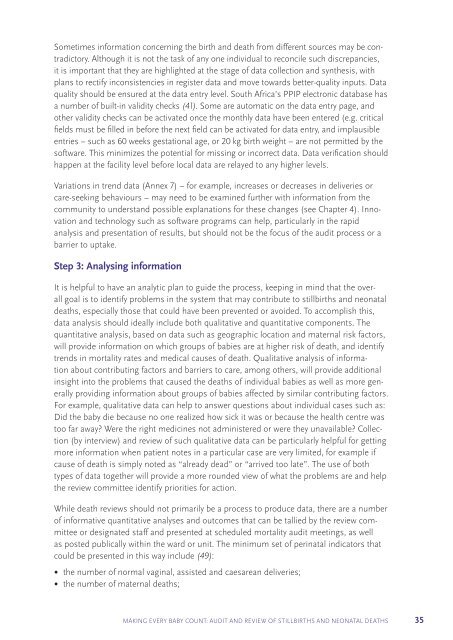Making Every Baby Count
9789241511223-eng
9789241511223-eng
You also want an ePaper? Increase the reach of your titles
YUMPU automatically turns print PDFs into web optimized ePapers that Google loves.
Sometimes information concerning the birth and death from different sources may be contradictory.<br />
Although it is not the task of any one individual to reconcile such discrepancies,<br />
it is important that they are highlighted at the stage of data collection and synthesis, with<br />
plans to rectify inconsistencies in register data and move towards better-quality inputs. Data<br />
quality should be ensured at the data entry level. South Africa’s PPIP electronic database has<br />
a number of built-in validity checks (41). Some are automatic on the data entry page, and<br />
other validity checks can be activated once the monthly data have been entered (e.g. critical<br />
fields must be filled in before the next field can be activated for data entry, and implausible<br />
entries – such as 60 weeks gestational age, or 20 kg birth weight – are not permitted by the<br />
software. This minimizes the potential for missing or incorrect data. Data verification should<br />
happen at the facility level before local data are relayed to any higher levels.<br />
Variations in trend data (Annex 7) – for example, increases or decreases in deliveries or<br />
care-seeking behaviours – may need to be examined further with information from the<br />
community to understand possible explanations for these changes (see Chapter 4). Innovation<br />
and technology such as software programs can help, particularly in the rapid<br />
analysis and presentation of results, but should not be the focus of the audit process or a<br />
barrier to uptake.<br />
Step 3: Analysing information<br />
It is helpful to have an analytic plan to guide the process, keeping in mind that the overall<br />
goal is to identify problems in the system that may contribute to stillbirths and neonatal<br />
deaths, especially those that could have been prevented or avoided. To accomplish this,<br />
data analysis should ideally include both qualitative and quantitative components. The<br />
quantitative analysis, based on data such as geographic location and maternal risk factors,<br />
will provide information on which groups of babies are at higher risk of death, and identify<br />
trends in mortality rates and medical causes of death. Qualitative analysis of information<br />
about contributing factors and barriers to care, among others, will provide additional<br />
insight into the problems that caused the deaths of individual babies as well as more generally<br />
providing information about groups of babies affected by similar contributing factors.<br />
For example, qualitative data can help to answer questions about individual cases such as:<br />
Did the baby die because no one realized how sick it was or because the health centre was<br />
too far away? Were the right medicines not administered or were they unavailable? Collection<br />
(by interview) and review of such qualitative data can be particularly helpful for getting<br />
more information when patient notes in a particular case are very limited, for example if<br />
cause of death is simply noted as “already dead” or “arrived too late”. The use of both<br />
types of data together will provide a more rounded view of what the problems are and help<br />
the review committee identify priorities for action.<br />
While death reviews should not primarily be a process to produce data, there are a number<br />
of informative quantitative analyses and outcomes that can be tallied by the review committee<br />
or designated staff and presented at scheduled mortality audit meetings, as well<br />
as posted publically within the ward or unit. The minimum set of perinatal indicators that<br />
could be presented in this way include (49):<br />
• the number of normal vaginal, assisted and caesarean deliveries;<br />
• the number of maternal deaths;<br />
MAKING EVERY BABY COUNT: AUDIT AND REVIEW OF STILLBIRTHS AND NEONATAL DEATHS<br />
35
















